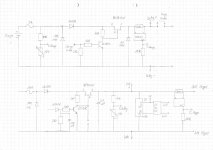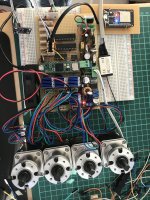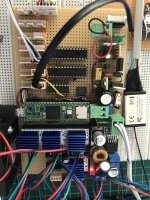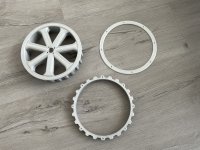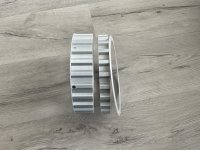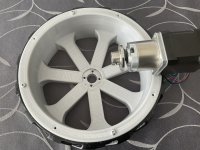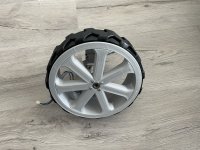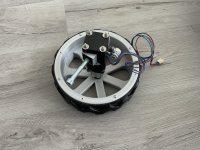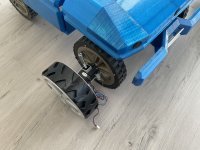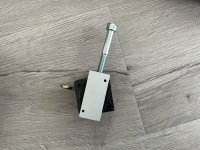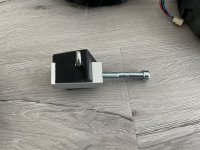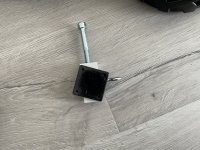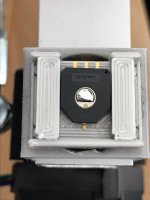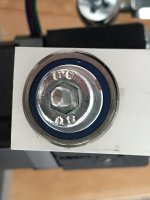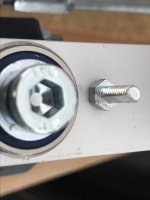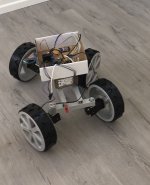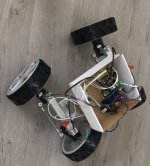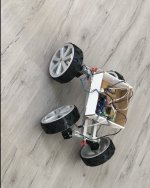Fürst Ruprecht
Well-known member
Hier geht es um einen Mähroboter mit Allrad - Antrieb und Allrad - Lenkung.
Die Lenkung soll geschwindigkeitsabhängig die hinteren Räder ansteuern:
Langsam:
/—/ Vorn
\—\ Hinten
Schnell:
/—/ Vorn
/—/ Hinten
Aktuelle Basis :
Teensy4.1,
Nema 17 Stepper mit 19.1:1 Getriebe,
TMC2208 Stepper Driver,
Platine DIY.
Port - Erweiterung mit MCP23S17 (16bit I/O-Expander) und MCP3008 (8-Channel 10-bit A/D-Converter).
Spannungsmessung mit Ina139 (analog) an MCP3008.
Software ist eine Modifikation auf Basis von der hier verwendeten Teensy-AzuritBer Version.
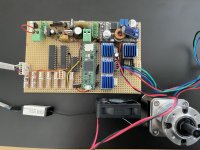
Hardware:
Mein erstes Problem: Ich nutze bei der Spannungsversorgung an Stelle des IRF9540N ( Mosfet P-Kanal) den IRLIZ44N ( Mosfet N-Kanal). Dadurch kehrt sich die Polarität bei der Ansteuerung um. Problem: der Spannungsabfall liegt bei ca. 2V (leitend). Ist das normal ?
Software:
Der Entfall der Odometrie führt zu umfangreichen Änderungen in der Software. Solange der Steppermotor dreht, kennt man die Radbewegung und muß sie nicht ermitteln, daher wird das Zählen der Ticks am Rad durch eine Berechnung über die gemachten Steps ersetzt. Die Motoren werden jedoch nicht per Steps angesteuert, sondern durch die Vorgabe einer Drehzahl, die vom Stepper-Driver intern in Steps gewandelt wird.
Ursprünglich wollte ich die Sonar Sensoren über den MCP23S17 ansteuern. Dazu sollte das Echosignal einen Interrupt auslösen und dann der Teensy über die Zeitdifferenz zwischen Tricker und Interrupt die Distanz berechnen. Das hat bis jetzt leider nicht funktioniert, die Zeiten sind völlig unbrauchbar.
Aktueller Stand:
Platine funktioniert soweit. Motoren sind per RC-Fernbedienung steuerbar. Programm ist (bis auf I/O-Expander) grob angepaßt.
Gruß Fürst Ruprecht
Die Lenkung soll geschwindigkeitsabhängig die hinteren Räder ansteuern:
Langsam:
/—/ Vorn
\—\ Hinten
Schnell:
/—/ Vorn
/—/ Hinten
Aktuelle Basis :
Teensy4.1,
Nema 17 Stepper mit 19.1:1 Getriebe,
TMC2208 Stepper Driver,
Platine DIY.
Port - Erweiterung mit MCP23S17 (16bit I/O-Expander) und MCP3008 (8-Channel 10-bit A/D-Converter).
Spannungsmessung mit Ina139 (analog) an MCP3008.
Software ist eine Modifikation auf Basis von der hier verwendeten Teensy-AzuritBer Version.

Hardware:
Mein erstes Problem: Ich nutze bei der Spannungsversorgung an Stelle des IRF9540N ( Mosfet P-Kanal) den IRLIZ44N ( Mosfet N-Kanal). Dadurch kehrt sich die Polarität bei der Ansteuerung um. Problem: der Spannungsabfall liegt bei ca. 2V (leitend). Ist das normal ?
Software:
Der Entfall der Odometrie führt zu umfangreichen Änderungen in der Software. Solange der Steppermotor dreht, kennt man die Radbewegung und muß sie nicht ermitteln, daher wird das Zählen der Ticks am Rad durch eine Berechnung über die gemachten Steps ersetzt. Die Motoren werden jedoch nicht per Steps angesteuert, sondern durch die Vorgabe einer Drehzahl, die vom Stepper-Driver intern in Steps gewandelt wird.
Ursprünglich wollte ich die Sonar Sensoren über den MCP23S17 ansteuern. Dazu sollte das Echosignal einen Interrupt auslösen und dann der Teensy über die Zeitdifferenz zwischen Tricker und Interrupt die Distanz berechnen. Das hat bis jetzt leider nicht funktioniert, die Zeiten sind völlig unbrauchbar.
Aktueller Stand:
Platine funktioniert soweit. Motoren sind per RC-Fernbedienung steuerbar. Programm ist (bis auf I/O-Expander) grob angepaßt.
Gruß Fürst Ruprecht

